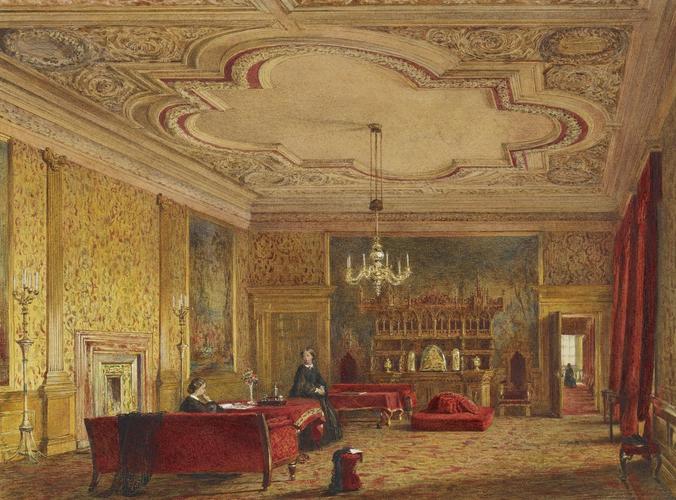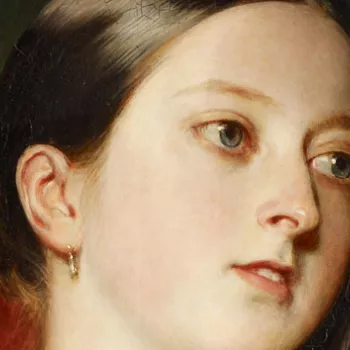The Presence Chamber or Evening (Outer) Drawing Room, Palace of Holyroodhouse 1863
Watercolour and bodycolour with touches of gum arabic over pencil, with some scratching out | 29.3 x 39.7 cm (sheet of paper) | RCIN 919567
-
A watercolour showing two ladies in a room. One seated, the other standing, probably representing two of the Princesses. On the right, a view through the door to the Great Staircase.
The Palace of Holyroodhouse was used as a royal residence by Queen Victoria and her family from 1850 onwards, a convenient stopping point on the journey north from London or Windsor to Balmoral Castle in the Highlands. Victoria and her husband first saw the Palace during a carriage ride through Edinburgh on their first visit to Scotland in September 1842, but did not visit it properly until 1850, when they spent two nights in 'the interesting & antient Palace of my ancestors' (Queen Victoria's journal, 29th August 1850) during which they climbed to the top of Arthur's Seat, an ancient volcano. While in Edinburgh Prince Albert also laid the foundation stone for the National Gallery of Scotland.
The principal rooms of the palace were extensively- and colourfully - redecorated before the first royal visit in 1850. The interior decoration was carried out by the Edinburgh firm D.R. Hay & Co., who were previously employed by Sir Walter Scott at Abbotsford and had a reputation for experimental colour schemes. Hay's interior schemes no longer survive, but a series of watercolours (including this one) by George Grieg, an Edinburgh watercolour artist who specialised in painting old, picturesque Scottish buildings, records their appearance. The Gothic sideboard and chairs, made in Coburg by Hoffmeister and Behrens, visible in this view were purchased at the Great Exhibition. This furniture is now in the collection of the Victoria & Albert Museum, London.
Queen Victoria appears to have first become aware of Greig's work through a birthday present of two watercolours of Scottish coastal scenes from her mother, the Duchess of Kent, in 1861; these gained extra emotional significance as the Duchess died two months before Victoria's birthday, and the Queen recorded in her journal receiving the '2 views in Cramond, in watercolours which were ordered by beloved Mama & are still her gift. Most touching!' (Queen Victoria's Journal, 24 May 1861). She then commissioned Greig herself, requesting a series of interior views of her rooms at the Palace of Holyroodhouse (including this one) and ten depicting places she stayed at with Albert during their travels in the Highlands in 1861. Only one of this latter category remains in the Royal Collection.
This was the last watercolour mounted by Queen Victoria and Princess Alice in View Album IX, which covered the years 1860-61. Queen Victoria and Prince Albert compiled nine View Albums during their marriage. These albums contained watercolours and drawings documenting their life together and were arranged in chronological order. A few weeks after Albert's death on 14 December 1861, his widow vowed to finish the series, writing emphatically 'I shall end them, for ever, with last year.' The albums were dismantled in the early twentieth century and rebound in new volumes both in a different arrangement and with additional items, but a written record of their original contents and arrangement still exists.Provenance
Commissioned by Queen Victoria for her Souvenir Album; Greig was paid 40gns each for this and two other watercolours (DMV, nos 2225 and 2226) on 28 April 1863
-
Creator(s)
-
Medium and techniques
Watercolour and bodycolour with touches of gum arabic over pencil, with some scratching out
Measurements
29.3 x 39.7 cm (sheet of paper)
Other number(s)
RL 19567










